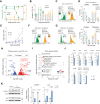Conserved role of hnRNPL in alternative splicing of epigenetic modifiers enables B cell activation
- PMID: 38744970
- PMCID: PMC11169469
- DOI: 10.1038/s44319-024-00152-3
Conserved role of hnRNPL in alternative splicing of epigenetic modifiers enables B cell activation
Abstract
The multifunctional RNA-binding protein hnRNPL is implicated in antibody class switching but its broader function in B cells is unknown. Here, we show that hnRNPL is essential for B cell activation, germinal center formation, and antibody responses. Upon activation, hnRNPL-deficient B cells show proliferation defects and increased apoptosis. Comparative analysis of RNA-seq data from activated B cells and another eight hnRNPL-depleted cell types reveals common effects on MYC and E2F transcriptional programs required for proliferation. Notably, while individual gene expression changes are cell type specific, several alternative splicing events affecting histone modifiers like KDM6A and SIRT1, are conserved across cell types. Moreover, hnRNPL-deficient B cells show global changes in H3K27me3 and H3K9ac. Epigenetic dysregulation after hnRNPL loss could underlie differential gene expression and upregulation of lncRNAs, and explain common and cell type-specific phenotypes, such as dysfunctional mitochondria and ROS overproduction in mouse B cells. Thus, hnRNPL is essential for the resting-to-activated B cell transition by regulating transcriptional programs and metabolism, at least in part through the alternative splicing of several histone modifiers.
Keywords: Alternative Splicing; Antibody Response; B Cell Activation; RNA Binding Protein; hnRNP.
© 2024. The Author(s).
Conflict of interest statement
The authors declare no competing interests.
Figures












References
-
- Bhattacharya S, Levy MJ, Zhang N, Li H, Florens L, Washburn MP, Workman JL (2021) Gene expression omnibus GSE151296 (https://www.ncbi.nlm.nih.gov/geo/query/acc.cgi?acc=GSE151296). [DATASET]
MeSH terms
Substances
Grants and funding
LinkOut - more resources
Full Text Sources
Molecular Biology Databases
Research Materials

